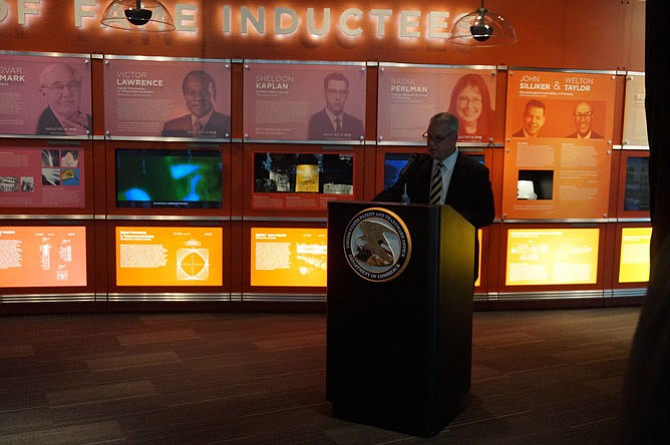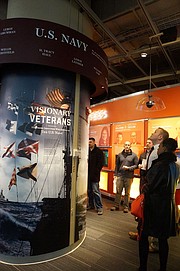Frederick Steckler, chief administrative officer for the U.S. Patent and Trademark Office, makes remarks prior to unveiling the Visionary Veterans exhibit Nov. 10 at the National Inventors Hall of Fame. Photo by Jeanne Theismann.
On the surface, they have little in common. Lewis Latimer was the child of escaped slaves while Maxime Faget dreamed of life beyond the stars nearly a century later. What they shared was a commitment to serve their country and a vision to make the future better for those that followed in their footsteps.
The accomplishments of Latimer and Faget are part of the Visionary Veterans exhibit at the National Inventors Hall of Fame. The new exhibit, unveiled Nov. 10 inside the U.S. Patent and Trademark Office, honors the 25 National Inventors Hall of Fame Inductees who served in the U.S. Navy dating back to the Civil War.
The exhibit highlights the stories of five NIHF Inductee Navy veterans whose future inventions helped redefine technology and commerce. Among the accomplishments of Navy veterans are Latimer’s invention of the carbon filament that made incandescent lighting practical and Leroy Grumman’s invention of retractable landing gear and folding wing technology.
The exhibit profiles include:
Lewis Latimer (inventor of durable carbon filament that made incandescent lighting practical) – Not only did Latimer lie about his age to join the Navy, he was also a child of escaped slaves, worked with Thomas Edison and fought in the Civil War.
Frank Sprague (prolific inventor known as the “father of electric traction” for his work in all types of electric transportation, streetcars and elevators) — Sprague was a member of the Navy in Peacetime (c. 1878), while also serving on the Naval Consulting Board as a civilian during and post WWI.
Leroy Grumman (inventor of retractable landing gear and folding wing technology) — Grumman spent his military days serving in WWI, while post war his company produced Navy Hellcat planes, which were largely credited with winning the war in the Pacific in WWII.
Maxime Faget (conceived and designed the first space capsule) — Faget took his WWII Submarine service to the next level when designing the Mercury spacecraft and all subsequent U.S. spacecraft.
Lloyd Conover (inventor of the antibiotic tetracycline) — Conover, the only living veteran from the exhibit, served during WWII and devoted his time in LST (landing ship tank) service in the Pacific.
The names of veteran Hall of Fame inductees are highlighted in blue in the Gallery of Icons wall at the National Inventors Hall of Fame Museum, which is located inside the U.S. Patent and Trademark Office and is open to the public.
The Visionary Veterans exhibit at the National Inventors Hall of Fame Museum will run through Veterans Day 2017. For more information, visit www.invent.org/visionary-veterans/






